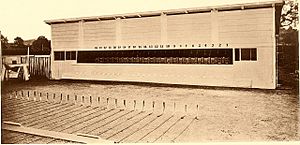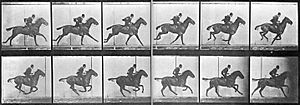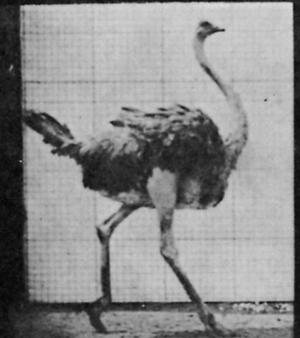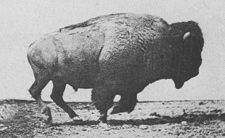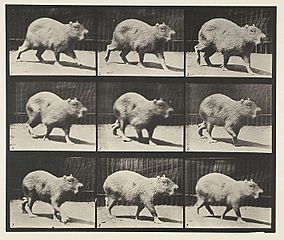Animal Locomotion facts for kids
Animal Locomotion: An Electro-photographic Investigation of Consecutive Phases of Animal Movements (1872–1885) is a series of scientific photographs by Eadweard Muybridge to study motion in animals including humans. In all, over 100,000 images were made, resulting in a portfolio of 781 composite collotype prints published in 1887.
Following his invention of the zoöpraxiscope and motion studies in California, Muybridge was commissioned by the University of Pennsylvania to oversee the photographic aspects of a scientific study of animal movement. Work from the commission was subsequently published as an eleven-volume portfolio set titled Animal Locomotion. The body of work is celebrated for its contribution to both the art of photography and to science.
Contents
History
In 1879, Muybridge created the zoöpraxiscope (animal action viewer), a projection device that created cyclical animations of animal movement, incorporating technologies from photography, the magic lantern and the zoetrope. The photographer created painted sequences on the glass zoöpraxiscope discs that were based on his motion-study photographs to produce an early form of animation. Muybridge used these to illustrate his lectures that were presented to audiences in the U.S. and Europe, marking his contribution to photography and film in relation to the "experience of time within modernity."
In a 1885 news report, the photographer stated that his interest in animal movement was inspired by observing an eagle flying in the Yosemite Valley in California some years prior. Muybridge described the bird as making "numerous flaps with its wings, but in flying across a valley to another peak it went for a distance of over a mile with but one flap of the wings. I was convinced that individual feather movements upheld and propelled the bird, and I can prove by the negative plates of the eagle whose flight we photographed last Thursday that my conclusion was correct." These earlier photographs in California formed the basis for his later work with the University of Pennsylvania.
While working in California, Muybridge used the wet-plate collodion process in making his albumen-print photographs. Once he got to Philadelphia, he began to employ a standardized dry-plate process, involving quicker exposure times; these were printed using the collotype photomechanical process.
Muybridge commission
The Animal Locomotion project was a collaborative endeavor between the photographer and the institutional commissioning committee at the University of Pennsylvania. In 1883, Muybridge met with William Pepper and J.B. Lippincott to discuss a plan for a scientific study focused on the analysis of animal and human movement. The university contributed $5,000 to what would be a total cost of about $30,000, seeing the proposed project as important research that would benefit anthropology, physiology, medicine and sports. Using a 12-camera photographic rig, Muybridge made series of sequential images that captured humans walking down stairs, pole vaulting, running, wrestling and other activities. Muybridge's chronophotographic studies included animals as well, and even exotic species borrowed from the Philadelphia Zoo. These plates included The Horse in Motion, Capybara Walking depicting the world's largest rodent, Ostrich Running (also printed as a cyanotype) and American Bison Cantering, among other representations of animals. Some of these studies were conducted using a 24-camera photographic rig. The cameras were placed 27-inches apart alongside a track containing trip wires that triggered the shutters on the cameras.
Between the years of 1883 and 1886, Muybridge was engaged in a productive period at the University of Pennsylvania when he and his team produced over 100,000 images of locomotion in humans and animals. The painter Thomas Eakins worked with him briefly, although the painter preferred working with multiple exposures on a single negative, whereas Muybridge preferred capturing motion through the use of multiple cameras.
Content and publication
Muybridge would publish his study as an eleven volume set, consisting of 781 plates, each presenting the successive photographic images of a single subject, under the title Animal Locomotion. Alternatively, individual subscribers had the option of selecting 100 plates of their choosing from the portfolio's prospectus and complete catalog for $100. Contrary to the animal focus suggested by the title of the collection, only about 200 of the images represented subjects other than humans, and many of the animal plates featured horses, the latter partially a consequence of Muybridge's offering private owners to photograph their horses in exchange for a contribution to the cost of the study. Though the animals were typically photographed running or walking across the frame, human subjects were also portrayed performing activities ranging from typical daily tasks to competitive athletics.
Impact on other artists
Historians and theoreticians have proposed that Muybridge's work on animal locomotion influenced a number of other artists, photographers and filmmakers, including Marcel Duchamp, Thomas Eakins, Walt Disney, among others. The composer, Philip Glass created a three-part chamber opera titled The Photographer in 1982 that featured a slide show of the motion studies in the second act. The conceptual artist, Sol LeWitt was inspired by the serial nature of the Animal Locomotion studies, and produced works that directly refers to it.
In 1992, the Addison Gallery of American Art produced the exhibition, Motion and Document–Sequence and Time: Eadweard Muybridge and Contemporary American Photography, pairing Muybridge's animal motion studies with the work of 42 artists and photographers among them Vito Acconci and Sarah Charlesworth. The show later traveled to the Long Beach Museum of Art.
Collections
The University of Pennsylvania houses the Muybridge Collection, which contains 740 of the 781 plates, along with some of his photographic equipment. Images from the series are held in numerous permanent collections including the Royal Academy of Arts, Pennsylvania Academy of Fine Arts, the Metropolitan Museum, the Brooklyn Museum, the Museum of Modern Art and others.
Gallery


